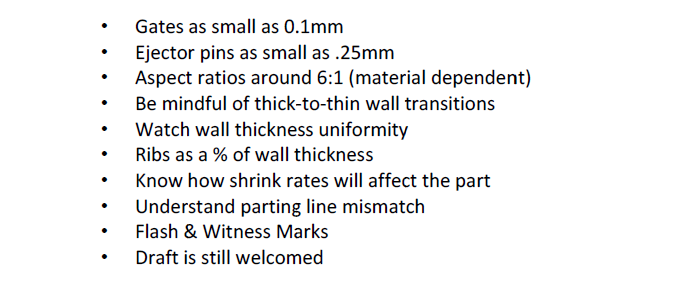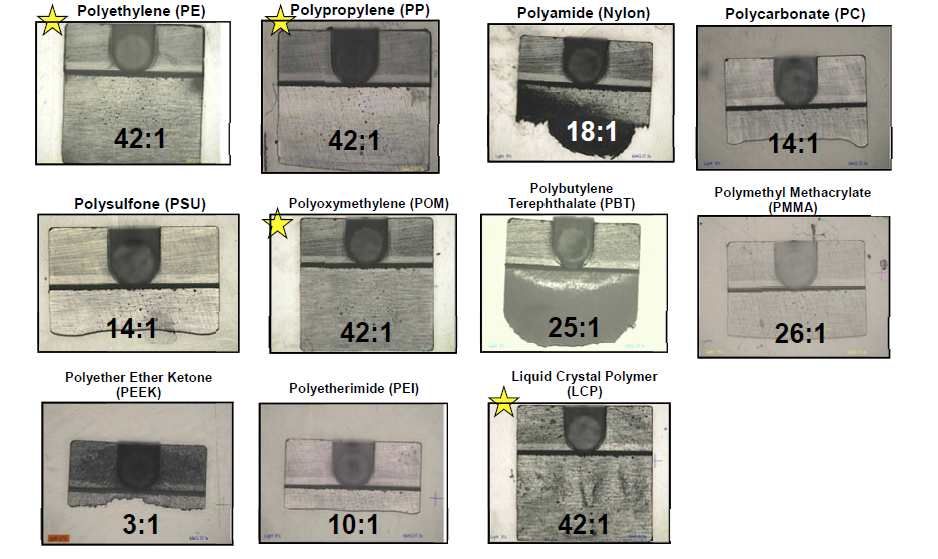It’s mind-boggling to think how far we’ve come from 1941’s 30 ton room-sized Colossus computer, to the pocket-sized mini-computers of the present. Even thirty years ago when the progenitor of the first mobile phone was taking off, one could scarcely conceive that the exclusive brick-like Motorola DynaTAC would not just evolve into an internet-enabled hub, but disseminate across the majority of the population. What was once unprecedented has now become common place.

As technological advancements have bred smaller, faster, and cheaper electronics, the primary objective has now matured beyond the point of miniaturization, where seeking to gain more out of the same footprint is the new goal. This is where micro-molding comes into account, a process that’s been around for the last 25 years but has only taken off in the last 10 years with the advent of micro plastics. Bear in mind that just as micro-molding has furthered miniaturization, it’s also the primary driver of expansion, and responsible for the massive 54” wide screen television panels of today, or any other technology that up-scales capacity.
Why does this matter to you?
Simply put, because the goals are the same: making things higher performing, more cost effective, and less invasive. Below you’ll find a brief rundown of the five key components of micro-molding that everyone should know, in order “to help you understand how to best approach micro injection molding so that it’s the design that wins the creative battle.”
For the detailed version, be sure to download the free White Paper at the bottom of article.
1. Understand the design
When dealing with micro-molding, understanding the design process is paramount so that you know what you can and cannot get away with, as even the most minute design alteration can stagger the entire project. The phrase “starting with the end in mind” cannot possibly echo any louder. For example, instituting a 5% change in dimension to a project that requires a .005” wall thickness will completely undermine the integrity of whether or not the part will fill the injection-mold.
Adhering to this principle, one should also consider the final function of the end product when designing components to guarantee that any mating parts properly fit; just because you can design something microscopic on a PC, doesn’t actually mean it can be fabricated. There way too many variables in play to establish final rules, but some general guidelines to consider include:

2. Material selection goes beyond the datasheet
Material selection plays a huge role in micro-molding, as different materials incite different outcomes. Considering that there are over 85,000 datasheets from over 860 different resin suppliers worldwide, you must tread very carefully when making your selection because the selected materials play a huge role in micro-molding, as different materials incite different outcomes.
Once you’ve consulted the resin databases and matched up the part requirements with the available materials, then you must prototype the sample in order to push the limits of micro-molding and observe how the material affects mold-ability when building a very thin model. After all, your intended part may be smaller than the example dimensions listed in the datasheet. Since the end results are very much tied to the design itself, it’s a good idea to obtain advice from the resin expert themselves.

A wide variety of materials produce different results when it comes to filling thin areas.
3. How to overcoming the challenges of prototyping
Prototyping is one of the most important phases of the design process, testing mechanical functionality, cosmetics, material compatibility or longevity. Prototyping for micro parts gives you the option of changing your design early on in case unwanted results should arise. At this point in the design process, you’ll want to use as many of the commonly available proto-typing techniques as possible to construct a sample that embodies the dimensional size of what’ll become a final part.
11 commonly used micro-molding prototyping techniques include: stereolithography (SLA), 3D Printing, polyJet, fusion deposition modeling (FDM), selective laser sintering (SLS), laminated object manufacturing (LOM), cast urethanes, maching/rapid tooling, rapid injection molding (RIM), and standard hard tooling. Their performance differs, but ultimately, your part’s required criteria will determine the most suitable process.
4. Metrology, handling, and packaging
The fourth most important consideration in micro-molding is its post-production. It helps to ask yourself what will happen to the part once it’s made. How are you going to receive it? For instance, miniaturized components with dimensions measuring a mere few hundred microns need to be handled in a very delicate manner, requiring pick-and-place machines, tape reels and anti-static packaging. Similarly, you’ll need measurement systems in place to actually validate the part’s integrity, as what you see with the naked eye cannot decipher.
5. Size & features drive innovation
The last important thing to know about micro-molding is: keep driving! Pushing the limits beyond roadblocks is a creative efficacy that has inspired many innovations. Accumold has accomplished many such innovations time and time again, and as a testament to its success, has demonstrated in the White Paper’s case studies how it used innovation to accomplish its customer’s micro-molding needs.
In one instance, the client required a delicate fabric mesh overmolded into a 2mm diameter cap without crushing the mesh or plastic to wick past the shut off and accidentally seal the opening. Other than the delicacy involved in molding the mesh itself, the biggest challenge was the Accumold did not initially have the system to build these parts. But that didn’t stop it from building the custom built injection unit needed to make that happen.
You’ll find three more case studies along deeper insight into micro-molding in the free 12 page White Paper below.
Advertisement
Learn more about Electronic Products Magazine





